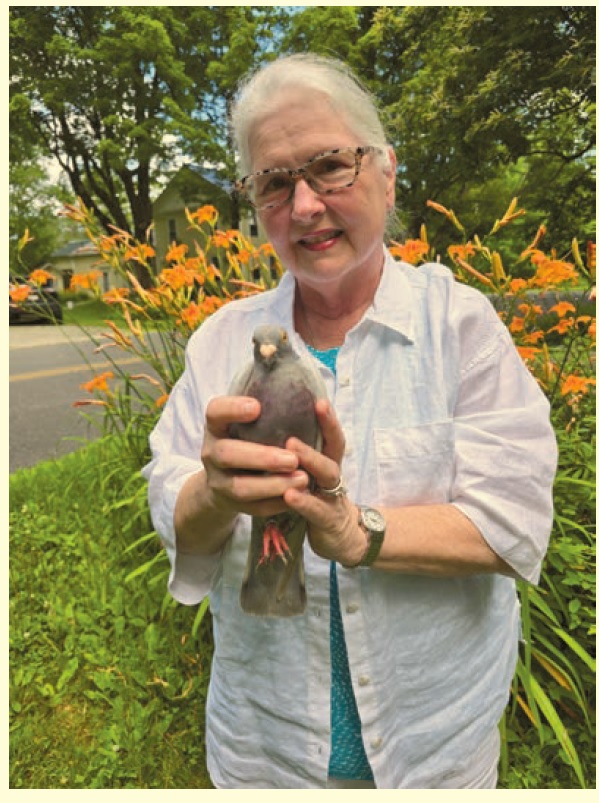| The Sandisfield Times |
|---|
| Two Pigeon Stories
A Second Chance for a Happy Ending |
|
Story and photo by Ron Bernard Published August 1, 2025 |
|
 Jean with her latest visiting homing pigeon. We should have named him "Lucky." Jean with her latest visiting homing pigeon. We should have named him "Lucky." Photo: Ron Bernard. About ten years ago Jean and I were enjoying an early evening dinner on our deck when an uninvited feathered guest arrived in the yard. It fluttered up to our table and began to drink from Jean's glass of water. How cheeky! But he was beautiful and tame. And, banded. A homing pigeon. We assumed it was a "he" and for sure he was exhausted and thirsty. He pecked at some of the food too. And then just parked himself with us. We finished our meal with him sitting on the table as if we'd invited him for dinner. Free to leave, he chose to hang around. For days. Now part of the family, we named him "Walter." What to do? Walter's leg band included a complicated, almost hieroglyphic-type code. An online search led one clue to another until we eventually reached someone at a Rhode Island pigeon racing club. "Yes, that's our bird," the man said. "He's coming from Ohio. He is resting and will leave on his own." The next morning, we found him on the edge of the road. He'd been run over while pecking the ground, as pigeons do. We informed the man at the club who said, ungratefully, "Why didn't you keep him safe?" We buried Walter respectfully beside a nice boulder under a tree in the yard. Although abating, our feeling of guilt remains. ****** Fast forward to July 12, 2025. Jean said, "Returning from the grocery store that afternoon, I saw something lying in the road near our house." It wasn't the usual casualty on Sandisfield's roads, namely, squirrel, chipmunk, or small turtle. "Flashers on, I got out to investigate. It was a pigeon, exhausted, exposed to traffic and lucky to be alive. It was banded." "Here we go again," she thought. Having the benefit of our previous experience, we put the bird in a dog cage with water and chicken food to let him recuperate while figuring out what do so as not to repeat our experience with Walter. Jean went on a tear, a mission, both hands working the phone and the computer. The search for advice and his owners was much better this time. Jean found an umbrella organization for pigeon racing clubs called, The International Federation of American Homing Pigeon Fanciers, based in nearby North Brookfield. Lost Bird Coordinator, Alex Cruz was very helpful. He determined that our bird's home base is in New Jersey. The standard advice about dealing with a banded pigeon is to keep it safe from predators and provide food (grains and seeds) and water and rest for 24 to 48 hours before release. They should go on their way. But after 36 hours our little visitor was still hanging around, less stressed but showing no signs of being ready to fly. We were concerned about his condition and wanted to avoid Walter's fate. Birdie wasn't keen to go back into the cage which led to a lot of sweet talk and a comical chase-and-capture by Jean. Several attempts to reach the New Jersey club were unsuccessful. Alex referred Jean to a local group for more advice, the Torrington (Conn.) Racing Pigeon Club, and "pigeon fancier" Andy Burdyl. They decided that our pigeon should be examined. Jean drove that day to Connecticut for a hand-over to Andy who said, "Look how thin he is. He never would have made it to New Jersey." Andy also said that this was probably a young male, only four or five months old, which may have been released as part of a training exercise and simply got lost. He needed at least a week of food and rest before he could go anywhere. Jean said, "Andy took the bird home to his pigeon loft where he promised to care for him and try to connect with its owners. I returned knowing I had done the right thing which likely saved the bird's life." So, our batting average with homing pigeons in Sandisfield is .500. If a Homing Pigeon Drops In . . . The leg band will contain codes and identifiers that pinpoint the bird's owners. The letters "IF" may be there which stands for The International Federation of American Homing Pigeon Fanciers at www.IFPigeon.com. The initials of the home club should be prominent. For example, "SRPC" might stand for "Sandisfield Racing Pigeons Club." Other identifying numbers might be useful to the organizations. In our two experiences, the standard advice was to let an uninjured bird recuperate for up to 48 hours and release it. That didn't work either time. We've found the best thing to do is to place the bird in a secure, comfortable cage and contact the IFAHPF or a local club if there is one. Be prepared to travel. |

|
©The Sandisfield Times. All rights reserved.
Published August 1, 2025